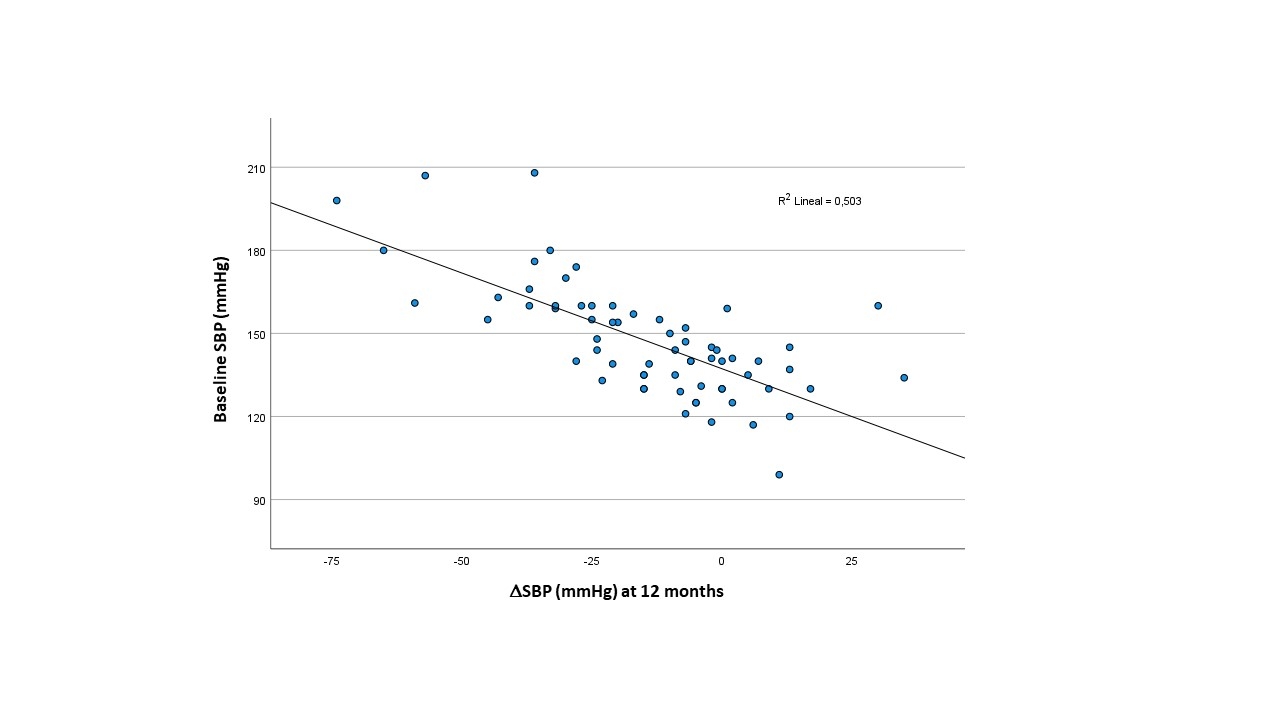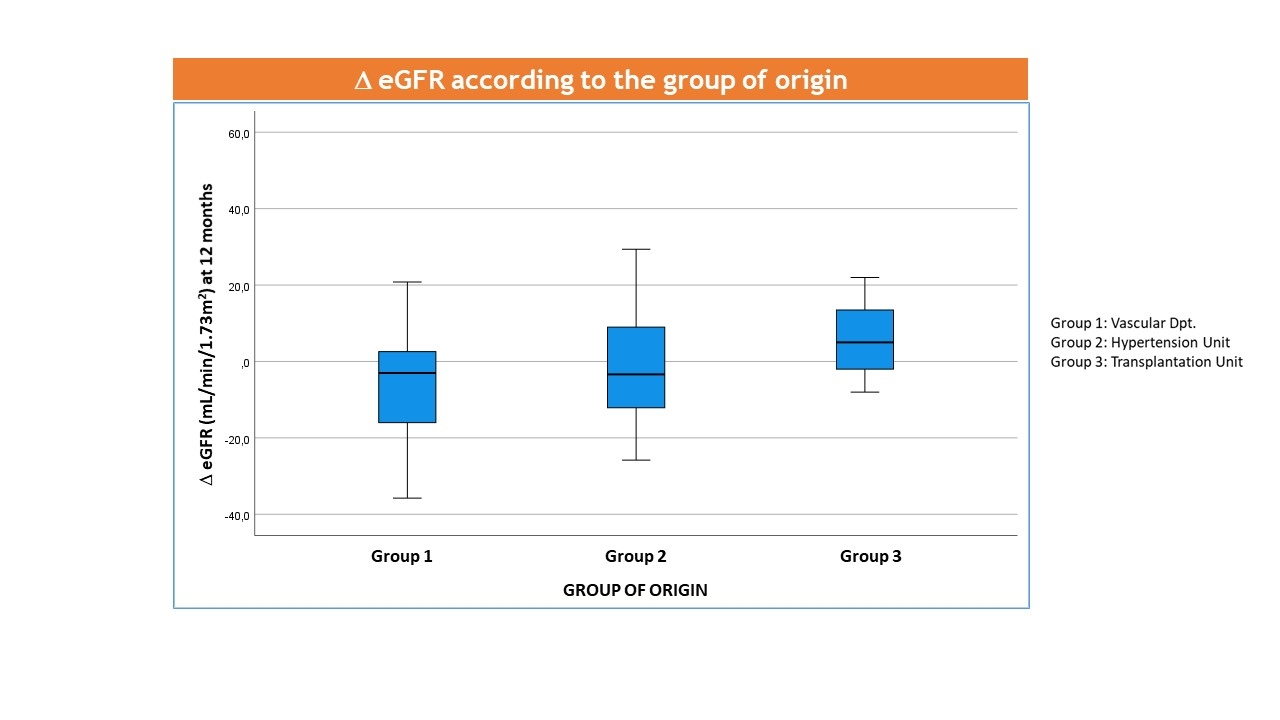Final ID: P-423
Blood Pressure and Renal Function Outcomes After Revascularization of Renal Artery Stenosis in Patients from 3 Different Clinical Settings
Abstract Body: The effects of renal percutaneous transluminal angioplasty (rPTA) of renal artery stenosis (RAS) on BP and renal function are controversial. We aim to search for possible differences in these outcomes in different clinical settings.
We conducted an observational analysis of effects of rPTA in patients with RAS diagnosed as a result of: screening patients with peripheral artery disease (Vascular Dpt.; G1, n = 20), patients with resistant hypertension or with clinical suspicion of RAS (Hypertension Unit; G2, n = 28) or kidney transplant patients with renal function impairment and/or elevation of BP (Transplantation Unit; G.3, n = 21). RAS is defined as a reduction of ≥70% of the renal artery lumen.
Sixty-nine patients were examined (mean age 67±12yr, 64% male). Overall, mean±S.D. baseline SBP/DBP (mmHg) was 147.4±20.6 and 75.7±1.8, and the estimated glomerular filtration rate (eGFR) was 48.7±27.0 mL/min/1.73m2. G.1 exhibited a higher prevalence of smoking patients (90%) and patients with past major vascular events (100%), lower DBP (70.0±9.8 mmHg) and better renal function (eGFR: 62.5±23.2 mL/min/1.73m2), compared to G.2 and G.3.
Twelve months after rPTA, BP decreased only in patients in G.2 and G.3: variation of (Δ) SBP(mmHg): mean (95%CI)= -18.9 (-26.7 to -11.0) and -20.0 (-29.8 to -10.1), respectively; p<0.001 for both; ΔDBP (mmHg): mean (95%CI)= -6.6 (-10.7 to -2.4), p=0.003 and -6.3 (-11.7 to -0.8), p=0.027, respectively. Regarding renal function, it only improved in G.3: ΔeGFR (mL/min/1.73m2): mean (95%CI)= 8.9 (1.5 to 16.4), p=0.022. ΔSBP was associated with baseline SBP (r= -0.709, p<0.001) and the origin group (Rho = -0.362, p = 0.003); ΔeGFR was associated with baseline eGFR (r= -0.508, p<0.001) and the origin group (Rho = 0.356, p = 0.004). Overall, median ΔSBP was -11 mmHg, and median ΔeGFR was +1.0 mL/min/1.73m2. An ANOVA analyzed factors associated with these changes. After adjusting for confounders, ΔSBP was dependent on baseline SBP and group of origin (both p<0.05; adjusted R2 0.340). ΔeGFR was dependent on baseline eGFR and diabetes (both p<0.05; adjusted R2 0.123).
Blood pressure decreased in patients with suspected RAS because of resistant hypertension 12 months after rPTA. Both BP and renal function improved after rPTA in kidney transplant patients with diagnosis of RAS. Higher BP levels and lower eGFR correlated with better results. Patients with peripheral artery disease screened for RAS showed no change in BP or renal function after rPTA.
We conducted an observational analysis of effects of rPTA in patients with RAS diagnosed as a result of: screening patients with peripheral artery disease (Vascular Dpt.; G1, n = 20), patients with resistant hypertension or with clinical suspicion of RAS (Hypertension Unit; G2, n = 28) or kidney transplant patients with renal function impairment and/or elevation of BP (Transplantation Unit; G.3, n = 21). RAS is defined as a reduction of ≥70% of the renal artery lumen.
Sixty-nine patients were examined (mean age 67±12yr, 64% male). Overall, mean±S.D. baseline SBP/DBP (mmHg) was 147.4±20.6 and 75.7±1.8, and the estimated glomerular filtration rate (eGFR) was 48.7±27.0 mL/min/1.73m2. G.1 exhibited a higher prevalence of smoking patients (90%) and patients with past major vascular events (100%), lower DBP (70.0±9.8 mmHg) and better renal function (eGFR: 62.5±23.2 mL/min/1.73m2), compared to G.2 and G.3.
Twelve months after rPTA, BP decreased only in patients in G.2 and G.3: variation of (Δ) SBP(mmHg): mean (95%CI)= -18.9 (-26.7 to -11.0) and -20.0 (-29.8 to -10.1), respectively; p<0.001 for both; ΔDBP (mmHg): mean (95%CI)= -6.6 (-10.7 to -2.4), p=0.003 and -6.3 (-11.7 to -0.8), p=0.027, respectively. Regarding renal function, it only improved in G.3: ΔeGFR (mL/min/1.73m2): mean (95%CI)= 8.9 (1.5 to 16.4), p=0.022. ΔSBP was associated with baseline SBP (r= -0.709, p<0.001) and the origin group (Rho = -0.362, p = 0.003); ΔeGFR was associated with baseline eGFR (r= -0.508, p<0.001) and the origin group (Rho = 0.356, p = 0.004). Overall, median ΔSBP was -11 mmHg, and median ΔeGFR was +1.0 mL/min/1.73m2. An ANOVA analyzed factors associated with these changes. After adjusting for confounders, ΔSBP was dependent on baseline SBP and group of origin (both p<0.05; adjusted R2 0.340). ΔeGFR was dependent on baseline eGFR and diabetes (both p<0.05; adjusted R2 0.123).
Blood pressure decreased in patients with suspected RAS because of resistant hypertension 12 months after rPTA. Both BP and renal function improved after rPTA in kidney transplant patients with diagnosis of RAS. Higher BP levels and lower eGFR correlated with better results. Patients with peripheral artery disease screened for RAS showed no change in BP or renal function after rPTA.
More abstracts on this topic:
Antithrombotic Therapy for Secondary Stroke Prevention in Patients with Severe Chronic Kidney Disease and Atrial Fibrillation
Jones Erica, Peterson Eric, Xian Ying, Ayodele Iyanuoluwa, Obrien Emily, Laskowitz Daniel, Fonarow Gregg, Matsouaka Roland, Schwamm Lee, Smith Eric, Bhatt Deepak
A20 in the Kidney Epithelium Attenuates Angiotensin II-induced Hypertension by Constraining Renal Tubular NHE3 ExpressionLu Xiaohan, Ren Jiafa, Wen Yi, Griffiths Robert, Yang Ting, Hammer Gianna, Zhuo Jia, Crowley Steven



